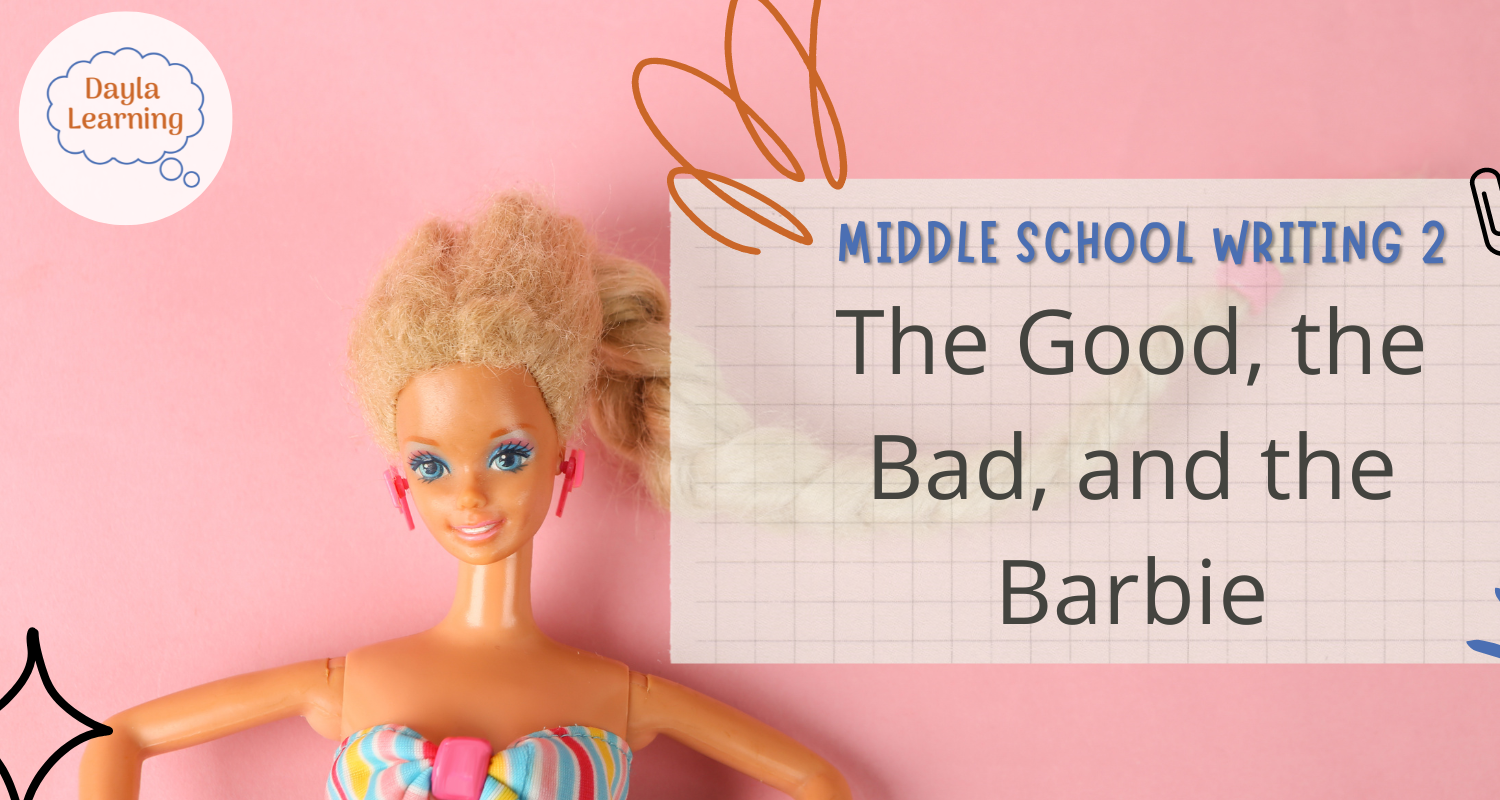Love her. Hate her. Love to hate her. Barbie has certainly left a lasting impression in her 60+ years.
This book tells the story of Barbie's creation, evolution, and controversies.
We'll use the book to talk about things like artistic intent vs. impact, the purpose of play, and more!
(And, yes, one of the options for a paper has been updated to include a comparison to the 2023 movie Barbie).
Gain Key Academic Writing and Reading Foundations
Students will learn foundational academic writing and reading skills including thesis statements, note taking, topic sentences, paragraph focus, and transitions. They will practice these skills through themed writing assignments based on the book.
Guided Class Flexibility
This is a guided class, which means there are no live meetings, but there are student-teacher interactions and weekly due dates for assignments. This format works well for students who don’t enjoy live, on-camera sessions or who have unpredictable weekly schedules.
Students can interact with the instructor and each other via our class discussion board.
Practice Writing as a Process
Most importantly, students will compose two multi-draft papers with individual video feedback on rough drafts and the opportunity to revise a final draft.
Class Details
Age Range: 11-13
Class Size: 3-10 Learners
Schedule:
Class runs from October 14-December 8, 2024 with no live meetings.
Supplies
To participate successfully in class, learners will need the following:
- A copy of The Good, the Bad, and the Barbie by Tanya Lee Stone (ISBN: 978-0-670-01187-2) (used copies are fine; borrowed/library copies are acceptable but it’s preferable for learners to have their own copy so they can take notes in it)
- PDF Reader
- Learners will submit work through Google Drive (a Google (Gmail) account can be acquired for free)
Meet Dr. Michelle Parrinello-Cason
Dr. Michelle Parrinello-Cason is the founder of Dayla Learning. She has a PhD in rhetoric and composition, a passion for helping students find their writing voice, and two homeschooling children of her own.
Michelle has taught in a wide variety of settings including six years as a full-time college professor. She has been teaching virtual and in-person homeschool writing and humanities classes for more than five years.
Michelle believes in meeting students where they are and — as any of her previous students will tell you — believes deeply that there is no such thing as a bad rough draft!

Is this the right fit for your learner?
This class is the mid-level option for my Middle School level classes (Middle School Writing Level 2). It’s designed for learners who have a basic introduction to writing but not much experience with formal academic writing assignments. Learners will do best if they have the following skills:
- Can write about 300 words (about 1 page double spaced) on a single topic
- Confidently reads texts at or above 700L on the Lexile rating
- Has practiced discussing reading material
- Has practiced writing about reading material (even if informally)
This class is a good fit for middle school readers who want to explore the connection between reading and writing in a supportive environment that will address their individual writing needs through personal feedback.
Skills Gained
The class is set up so that students choose which writing prompts they’d like to complete for both of the two primary assignments. This means that students of varying ability levels and familiarity with academic writing conventions can find an assignment appropriate for their level.
All students will learn about the following:
- Developing reading comprehension and note-taking strategies
- Finding their own writing process
- Working on a complete draft in stages that focus on revision
- Reflecting on what works to build strong writing habits
Depending on which assignments they choose to complete, students will focus specifically on the following:
- Crafting strong thesis statements
- Crafting narratives
- Writing creatively
- Finding similarities when making comparisons
- Creating multimodal projects to communicate ideas
- Incorporating sources into writing with appropriate citations
Common Core Standards Alignment
For those who are using Common Core standards, this course meets the following:
All Learners:
- CCSS.ELA-LITERACY.RI.6.1, 7.1, and 8.1 (citing textual evidence)
- CCSS.ELA-LITERACY.RI.6.2, 7.2, and 8.2 (identifying central ideas)
- CCSS.ELA-LITERACY.RI.6.3, 7.3, and 8.3 (analyzing details in informational texts)
- CCSS.ELA-LITERACY.RI.6.4, 7.4, and 8.4 (determining word meaning in context)
Depending on Paper Prompt Chosen:
- CCSS.ELA-LITERACY.W.6.1, 7.1, and 8.1 (write arguments with reason and evidence)
- CCSS.ELA-LITERACY.W.6.2, 7.2, and 8.2 (write informative texts to examine a topic)
- CCSS.ELA-LITERACY.W.6.3, 7.3, and 8.3 (write narratives with details)
- CCSS.ELA-LITERACY.W.6.4, 7.4, and 8.4 (write appropriately to audience)
- CCS.ELA-LITERACY.W.6.5, 7.5, and 8.5 (plan, revise, edit and rewrite)
- CCS.ELA-LITERACY.W.6.8, 7.8, and 8.8 (gather information from credible sources)
- CCS.ELA-LITERACY.W.6.9, 7.9, and 8.9 (draw textual evidence to support analysis and research)
- CCS.ELA-LITERACY.W.6.10, 7.10, and 8.10 (write routinely over extended time frames)
Upon successful completion of class, instructor provides detailed exit letter suitable for inclusion in portfolio. Families may request numerical grade at beginning of class for a detailed course grade summary, but it is optional.
Individual Support
All students will receive individualized video feedback on all rough drafts that specifically addresses their rough draft submissions.
My teaching philosophy very much focuses on starting with students’ strengths to build confidence and using them to work on improvements over time.
Feedback is tailored to each student’s individual needs and goals. I also encourage a lot of self-reflection and provide opportunities for students to directly communicate their challenges so that facing them with strategies becomes a normal part of the writing process.
Content Note
There is some brief discussion of eating disorders and body image. One chapter includes reference to Barbie being naked and kids using Barbie for romantic play. These descriptions are non-graphic and treated in context of Barbie's larger representation and controversies.
